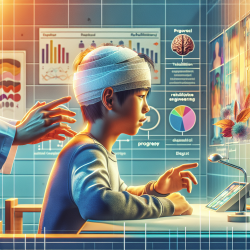Introduction
In the realm of pediatric rehabilitation, the integration of technology offers promising avenues for enhancing therapeutic outcomes. The research article, Our child’s TBI: a rehabilitation engineer’s personal experience, technological approach, and lessons learned, provides a unique perspective on the intersection of personal experience and technological innovation in the rehabilitation process. This blog post aims to distill key insights from the research, encouraging practitioners to refine their skills and explore new avenues for improving pediatric rehabilitation outcomes.
Understanding the Case
The article centers around the personal experience of James Sulzer, a rehabilitation engineer, whose daughter suffered a severe traumatic brain injury (TBI). This narrative highlights the challenges faced in the aftermath of the injury, including medical, personal, and technological aspects. The Sulzer family's journey underscores the importance of a multidisciplinary approach in pediatric rehabilitation, where technology plays a pivotal role in facilitating recovery.
Key Technological Approaches
Several technological interventions were explored during the rehabilitation process:
- Electronics and Communication Devices: The use of iPads and eye gaze tracking technology facilitated communication and engagement, providing a means for the child to interact with her environment.
- Peripheral Neurostimulation: Techniques like transcutaneous electrical nerve stimulation (TENS) and neuromuscular electrical stimulation (NMES) were employed to reduce spasticity and encourage muscle activation.
- Positioning Devices: Standers and specialized strollers were crucial in supporting posture and enabling participation in various activities.
Lessons for Practitioners
The Sulzer family's experience offers valuable lessons for practitioners in the field of pediatric rehabilitation:
- Embrace a Multidisciplinary Approach: Collaboration among therapists, engineers, and families is essential for developing comprehensive rehabilitation plans that address the unique needs of each child.
- Prioritize Evidence-Based Practices: While the field of pediatric TBI lacks extensive clinical trials, practitioners should strive to incorporate evidence-based practices and remain open to emerging research.
- Adaptability and Innovation: Practitioners should be willing to explore and adapt new technologies, keeping in mind the practical challenges and the need for simplicity and robustness in therapeutic devices.
Encouraging Further Research
The article highlights the need for ongoing research in pediatric rehabilitation, particularly in understanding the brain's recovery mechanisms and the efficacy of various therapeutic interventions. Practitioners are encouraged to engage in research collaborations and contribute to the growing body of knowledge in this field.
Conclusion
The journey of the Sulzer family provides a poignant reminder of the complexities and challenges in pediatric rehabilitation. By integrating technology and evidence-based practices, practitioners can enhance therapeutic outcomes and support the recovery of children with traumatic brain injuries. To delve deeper into the insights and experiences shared in the research article, please follow this link: Our child’s TBI: a rehabilitation engineer’s personal experience, technological approach, and lessons learned.










